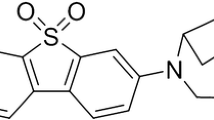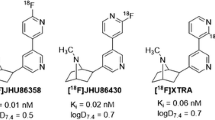Abstract
Purpose
The α7 nicotinic acetylcholine receptor (nAChR) is implicated in many neuropsychiatric disorders, making it an important target for positron emission tomography (PET) imaging. The first aim of this work was to compare two α7 nAChRs PET radioligands, [18F]ASEM (3-(1,4-diazabicyclo[3.2.2]nonan-4-yl)-6-([18F]fluorodibenzo[b,d]thiophene 5,5-dioxide) and [18F]DBT-10 (7-(1,4-diazabicyclo[3.2.2]nonan-4-yl)-2-([18F]fluorodibenzo[b,d]thiophene 5,5-dioxide), in nonhuman primates. The second aim was to assess further the quantification and test-retest variability of [18F]ASEM in humans.
Methods
PET scans with high specific activity [18F]ASEM or [18F]DBT-10 were acquired in three rhesus monkeys (one male, two female), and the kinetic properties of these radiotracers were compared. Additional [18F]ASEM PET scans with blocking doses of nicotine, varenicline, and cold ASEM were acquired separately in two animals. Next, six human subjects (five male, one female) were imaged with [18F]ASEM PET for 180 min, and arterial sampling was used to measure the parent input function. Different modeling approaches were compared to identify the optimal analysis method and scan duration for quantification of [18F]ASEM distribution volume (V T). In addition, retest scans were acquired in four subjects (three male, one female), and the test-retest variability of V T was assessed.
Results
In the rhesus monkey brain [18F]ASEM and [18F]DBT-10 exhibited highly similar kinetic profiles. Dose-dependent blockade of [18F]ASEM binding was observed, while administration of either nicotine or varenicline did not change [18F]ASEM V T. [18F]ASEM was selected for further validation because it has been used in humans. Accurate quantification of [18F]ASEM V T in humans was achieved using multilinear analysis with at least 90 min of data acquisition, resulting in V T values ranging from 19.6 ± 2.5 mL/cm3 in cerebellum to 25.9 ± 2.9 mL/cm3 in thalamus. Test-retest variability of V T was 11.7 ± 9.8%.
Conclusions
These results confirm [18F]ASEM as a suitable radiotracer for the imaging and quantification of α7 nAChRs in humans.





Similar content being viewed by others
References
Hurst R, Rollema H, Bertrand D. Nicotinic acetylcholine receptors: from basic science to therapeutics. Pharmacol Ther. 2013;137(1):22–54.
Kalkman HO, Feuerbach D. Modulatory effects of α7 nAChRs on the immune system and its relevance for CNS disorders. Cell Mol Life Sci. 2016;73(13):2511–30.
Beinat C, Banister SD, Herrera M, Law V, Kassiou M. The therapeutic potential of α7 nicotinic acetylcholine receptor (α7 nAChR) agonists for the treatment of the cognitive deficits associated with schizophrenia. CNS Drugs. 2015;29(7):529–42.
Echeverria V, Yarkov A, Aliev G. Positive modulators of the α7 nicotinic receptor against neuroinflammation and cognitive impairment in Alzheimer’s disease. Prog Neurobiol. 2016;144:142–157.
Philip NS, Carpenter LL, Tyrka AR, Price LH. Nicotinic acetylcholine receptors and depression: a review of the preclinical and clinical literature. Psychopharmacology. 2010;212: 1.
Brunzell DH, McIntosh JM, Papke RL. Diverse strategies targeting α7 homomeric and α6β2* heteromeric nicotinic acetylcholine receptors for smoking cessation. Ann N Y Acad Sci. 2014;1327:27–45.
Brust P, Peters D, Deuther-Conrad W. Development of radioligands for the imaging of α7 nicotinic acetylcholine receptors with positron emission tomography. Curr Drug Targets. 2012;13(5):594–601.
Toyohara J, Sakata M, Wu J, et al. Preclinical and the first clinical studies on [11C]CHIBA-1001 for mapping α7 nicotinic receptors by positron emission tomography. Ann Nucl Med. 2009;23(3):301–9.
Horti AG. Development of [18F]ASEM, a specific radiotracer for quantification of the α7-nAChR with positron-emission tomography. Biochem Pharmacol. 2015;97(4):566–75.
Horti AG, Gao Y, Kuwabara H, et al. 18F-ASEM, a radiolabeled antagonist for imaging the α7-nicotinic acetylcholine receptor with PET. J Nucl Med. 2014;55(4):672–7.
Wong DF, Kuwabara H, Pomper M, et al. Human brain imaging of α7 nAChR with [18F]ASEM: a new PET radiotracer for neuropsychiatry and determination of drug occupancy. Mol Imaging Biol. 2014;16(5):730–8.
Gao Y, Kellar KJ, Yasuda RP, et al. Derivatives of dibenzothiophene for positron emission tomography imaging of α7-nicotinic acetylcholine receptors. J Med Chem. 2013;56(19):7574–89.
Teodoro R, Scheunemann M, Deuther-Conrad W, et al. A promising PET tracer for imaging of α7 nicotinic acetylcholine receptors in the brain: design, synthesis, and in vivo evaluation of a dibenzothiophene-based radioligand. Molecules. 2015;20(10):18387–421.
Hillmer AT, Zheng MQ, Li S, et al. PET imaging evaluation of [18F]DBT-10, a novel radioligand specific to α7 nicotinic acetylcholine receptors, in nonhuman primates. Eur J Nucl Med Mol Imaging. 2016;43(3):537–47.
Nocente R, Vitali M, Balducci G, Enea D, Kranzler HR, Ceccanti M. Varenicline and neuronal nicotinic acetylcholine receptors: a new approach to the treatment of co-occurring alcohol and nicotine addiction? Am J Addict. 2013;22(5):453–9.
Coe JW, Brooks PR, Vetelino MG, et al. Varenicline: an α4β2 nicotinic receptor partial agonist for smoking cessation. J Med Chem. 2005;48(10):3474–7.
Mihalak KB, Carroll FI, Luetje CW. Varenicline is a partial agonist at α4β2 and a full agonist at α7 neuronal nicotinic receptors. Mol Pharmacol. 2006;70(3):801–5.
Jin X, Mulnix T, Gallezot J-D, Carson RE. Evaluation of motion correction methods in human brain PET imaging—A simulation study based on human motion data. Med Phys. 2013;40(10):102503.
Sandiego CM, Weinzimmer D, Carson RE. Optimization of PET-MR registrations for nonhuman primates using mutual information measures: a Multi-Transform Method (MTM). Neuroimage. 2013;64:571–81.
Rohlfing T, Kroenke CD, Sullivan EV, et al. The INIA19 template and neuromaps atlas for primate brain image parcellation and spatial normalization. Front Neuroinform. 2012;6:27.
Innis RB, Cunningham VJ, Delforge J, et al. Consensus nomenclature for in vivo imaging of reversibly binding radioligands. J Cereb Blood Flow Metab. 2007;27(9):1533–9.
Gunn RN, Gunn SR, Cunningham VJ. Positron emission tomography compartmental models. J Cereb Blood Flow Metab. 2001;21(6):635–52.
Ichise M, Liow JS, Lu JQ, et al. Linearized reference tissue parametric imaging methods: application to [11C]DASB positron emission tomography studies of the serotonin transporter in human brain. J Cereb Blood Flow Metab. 2003;23(9):1096–112.
Hurvich CM, Tsai C-L. Regression and time series model selection in small samples. Biometrika. 1989;76(2):297–307.
Cunningham VJ, Rabiner EA, Slifstein M, Laruelle M, Gunn RN. Measuring drug occupancy in the absence of a reference region: the Lassen plot re-visited. J Cereb Blood Flow Metab. 2010;30(1):46–50.
Guo Q, Owen DR, Rabiner EA, Turkheimer FE, Gunn RN. A graphical method to compare the in vivo binding potential of PET radioligands in the absence of a reference region: application to [11C]PBR28 and [18F]PBR111 for TSPO imaging. J Cereb Blood Flow Metab. 2014;34(7):1162–8.
Anderson DJ, Bunnelle W, Surber B, et al. [3H]A-585539 [(1S,4S)-2,2-dimethyl-5-(6-phenylpyridazin-3-yl)-5-aza-2-azoniabicyclo[2.2.1]heptane], a novel high-affinity alpha7 neuronal nicotinic receptor agonist: radioligand binding characterization to rat and human brain. J Pharmacol Exp Ther. 2008;324(1):179–87.
Deuther-Conrad W, Fischer S, Hiller A, et al. Assessment of α7 nicotinic acetylcholine receptor availability in juvenile pig brain with [18F]NS10743. Eur J Nucl Med Mol Imaging. 2011;38(8):1541–9.
Ettrup A, Mikkelsen JD, Lehel S, et al. 11C-NS14492 as a novel PET radioligand for imaging cerebral α7 nicotinic acetylcholine receptors: in vivo evaluation and drug occupancy measurements. J Nucl Med. 2011;52(9):1449–56.
Navarro HA, Zhong D, Abraham P, Xu H, Carroll FI. Synthesis and pharmacological characterization of [125I]iodomethyllycaconitine ([125I]iodo-MLA). A new ligand for the α7 nicotinic acetylcholine receptor. J Med Chem. 2000;43(2):142–5.
Xiao Y, Abdrakhmanova GR, Baydyuk M, Hernandez S, Kellar KJ. Rat neuronal nicotinic acetylcholine receptors containing α7 subunit: pharmacological properties of ligand binding and function. Acta Pharmacol Sin. 2009;30(6):842–50.
Whiteaker P, Davies AR, Marks MJ, et al. An autoradiographic study of the distribution of binding sites for the novel α7-selective nicotinic radioligand [3H]-methyllycaconitine in the mouse brain. Eur J Neurosci. 1999;11(8):2689–96.
Udesky JO, Spence NZ, Achiel R, Lee C, Flood P. The role of nicotinic inhibition in ketamine-induced behavior. Anesth Analg. 2005;101(2):407–11.
Flood P, Ramirez-Latorre J, Role L. α4β2 neuronal nicotinic acetylcholine receptors in the central nervous system are inhibited by isoflurane and propofol, but α7 - type nicotinice acetylcholine receptors are unaffected. Anesthesiology. 1997;86(4):859–65.
Grottick AJ, Trube G, Corrigall WA, et al. Evidence that nicotinic α7 receptors are not involved in the hyperlocomotor and rewarding effects of nicotine. J Pharmacol Exp Ther. 2000;294(3):1112–9.
Grady SR, Drenan RM, Breining SR, et al. Structural differences determine the relative selectivity of nicotinic compounds for native α4β2*-, α6β2*-, α3β4*- and α7-nicotine acetylcholine receptors. Neuropharmacol. 2010;58(7):1054–66.
Jorenby DE, Hays JT, Rigotti NA, et al. Efficacy of varenicline, an α4β2 nicotinic acetylcholine receptor partial agonist, vs placebo or sustained-release bupropion for smoking cessation: a randomized controlled trial. JAMA. 2006;296(1):56–63.
Rollema H, Shrikhande A, Ward KM, et al. Pre-clinical properties of the α4β2 nicotinic acetylcholine receptor partial agonists varenicline, cytisine and dianicline translate to clinical efficacy for nicotine dependence. Br J Pharmacol. 2010;160(2):334–45.
Acknowledgements
We thank the staff at the Yale PET Center for their expert technical assistance in support of this work. This work was supported by NIH T32 DA022975, R01 DA015577, K02 DA031750, K01 MH092681, and the Veterans Affairs National Center for PTSD. The Deutsche Forschungsgemeinschaft is acknowledged for financial support (Project DE 1165/2-3). This publication was also supported by CTSA Grant Number UL1 TR000142 from the National Center for Advancing Translational Science (NCATS), a component of the National Institutes of Health (NIH). Its contents are solely the responsibility of the authors and do not necessarily represent the official view of NIH.
Author information
Authors and Affiliations
Corresponding author
Ethics declarations
All applicable international, national, and institutional guidelines for the care and use of animals were followed. Procedures performed in studies involving animals were in accordance with the ethical standards of the Yale University Institutional Animal Care and Use Committee. All procedures performed in studies involving human participants were in accordance with the ethical standards of the institutional and/or national research committee and with the 1964 Helsinki declaration and its later amendments or comparable ethical standards. Informed consent was obtained from all individual participants included in the study. Procedures performed in studies involving human participants were in accordance with the ethical standards of the Yale University Institutional Review Board.
Funding
This work was supported by NIH T32 DA022975, R01 DA015577, K02 DA031750, K01 MH092681 and the Veterans Affairs National Center for PTSD. The Deutsche Forschungsgemeinschaft is acknowledged for financial support (Project DE 1165/2-3). This publication was also supported by CTSA Grant Number UL1 TR000142 from the National Center for Advancing Translational Science (NCATS), a component of the National Institutes of Health (NIH). Its contents are solely the responsibility of the authors and do not necessarily represent the official view of NIH.
Conflict of interest
The authors declare no conflict of interest.
Electronic supplementary material
Below is the link to the electronic supplementary material.
ESM 1
(PDF 687 kb)
Rights and permissions
About this article
Cite this article
Hillmer, A.T., Li, S., Zheng, MQ. et al. PET imaging of α7 nicotinic acetylcholine receptors: a comparative study of [18F]ASEM and [18F]DBT-10 in nonhuman primates, and further evaluation of [18F]ASEM in humans. Eur J Nucl Med Mol Imaging 44, 1042–1050 (2017). https://doi.org/10.1007/s00259-017-3621-8
Received:
Accepted:
Published:
Issue Date:
DOI: https://doi.org/10.1007/s00259-017-3621-8




